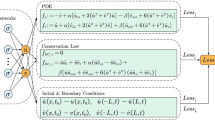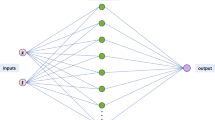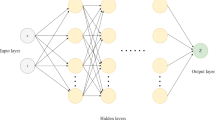Abstract
This paper investigates data-driven forward–inverse problems associated with the variable coefficients Hirota (VC-Hirota) equation using the physics-informed neural network (PINN) algorithm. First, we propose an improved PINN algorithm with a locally adaptive activation function to recover data-driven solitons and high-order solitons solutions for the VC-Hirota equation. Second, we demonstrate the effectiveness of the improved PINN algorithm in accurately predicting parameters under different noise intensities using a parameter regularization strategy and appropriate weight coefficients. Third, we introduce a PINNs approach that employs two neural networks to tackle the function discovery problem. The neural network with time and space coordinates in the input layer is used to train the prediction solution, and the neural network with only time coordinates in the input layer is trained to model the unknown function in the variable coefficient function. This work presents a successful attempt to use the PINN method to solve the function discovery problem of VC-Hirota equations.



















Similar content being viewed by others
Data availability
All date generated or analyzed during this study are included in this published article.
References
Hasegawa, A., Tappert, F.: Transmission of stationary nonlinear optical pulses in dispersive dielectric fibres I. Anomalous dispersion. Appl. Phys. Lett. 23, 142–144 (1973)
Gedalin, M., Scott, T.C., Band, Y.B.: Optical solitary waves in the higher order nonlinear Schrödinger equation. Phys. Rev. Lett. 78, 448–451 (1997)
Wazwaz, A.M., Hammad, M.A., El-Tantawy, S.A.: Bright and dark optical solitons for (3+1)-dimensional hyperbolic nonlinear Schrödinger equation using a variety of distinct schemes. Optik 270, 170043 (2022)
Wazwaz, A.M., Albalawi, W., El-Tantawy, S.A.: Optical envelope soliton solutions for coupled nonlinear Schrödinger equations applicable to high birefringence fibers. Optik 255, 168673 (2022)
Zabusky, N.J., Kruskal, M.D.: Interaction of solitons in a collisionless plasma and the recurrence of initial states. Phys. Rev. Lett. 15, 240–243 (1965)
Khaykovich, L., Schreck, F., Ferrari, G., Bourdel, T., Cubizolles, J., Carr, L.D., Castin, Y., Salomon, C.: Formation of a Matter-Wave bright soliton. Science 296, 1290–1293 (2002)
Palacios, S.L., Guinea, A., Fernandez-Diaz, J.M., Crespo, R.D.: Dark solitary waves in the nonlinear Schrödinger equation with third order dispersion, self-steepening, and self-frequency shift. Phys. Rev. E 60, 45–47 (1999)
Grelu, P., Akhmediev, N.: Dissipative solitons for mode-locked lasers. Nat. photonics 6, 84–92 (2012)
Kodama, Y.: Optical solitons in a Monomode fiber. J. Stat Phys. 39, 597–613 (1985)
Tao, Y. S., He, J. S.: The integrability and solvability for the variable coefficient higher-order nonlinear Schrödinger equation, consumer electronics, communications and networks (CECNet), international conference, pp. 5402-5405 (2011)
Papaioannou, E., Frantzeskakis, D.J., Hizanidis, K.: An analytical treatment of the effect of axial inhomogeneity on femtosecond solitary waves near the zero dispersion point. IEEE J. Quantum Elect. 32, 145–154 (1996)
Yang, R.C., Li, L., Hao, R.Y., Li, Z.H., Zhou, G.S.: Combined solitary wave solutions for the inhomogeneous higher-order nonlinear Schrödinger equation. Phys. Rev. E 71, 036616 (2005)
Dai, C.Q., Zhang, J.F.: New solitons for the Hirota equation and generalized higher-order nonlinear Schrödinger equation with variable coefficients. J. Phys. A: Math. Gen. 39, 723–737 (2006)
Wang, P., Tian, B., Liu, W.J., Li, M., Sun, K.: Soliton solutions for a generalized inhomogeneous variable-coefficient Hirota equation with symbolic computation. Stud. Appl. Math. 125, 213–222 (2010)
He, J.S., Tao, Y.S., Porsezian, K., Fokas, A.S.: Rogue wave management in an inhomogeneous nonlinear fibre with higher order effects. J. Nonlinear Math. Phy. 20, 407–419 (2013)
Rajan, M., Mahalingam, A.: Nonautonomous solitons in modified inhomogeneous Hirota equation: soliton control and soliton interaction. Nonlinear Dyn. 79, 2469–2484 (2015)
Gao, X.Y.: Looking at a nonlinear inhomogeneous optical fiber through the generalized higher-order variable-coefficient Hirota equation. Appl. Math. Lett. 73, 143–149 (2017)
Yang, D.Y., Tian, B., Hu, C.C., Liu, S.H., Shan, W.R., Jiang, Y.: Conservation laws and breather-to-soliton transition for a variable-coefficient modified Hirota equation in an inhomogeneous optical fiber. Wave. Random Complex (2021). https://doi.org/10.1080/17455030.2021.1983237
Zhou, H.J., Chen, Y.: High-order soliton solutions and their dynamics in the inhomogeneous variable coefficients Hirota equation. Commun. Nonlinear Sci. 120, 107149 (2023)
Hornik, K., Stinchcombe, M., White, H.: Universal approximation of an unknown mapping and its derivatives using multilayer feedforward networks. Neural Netw. 3, 551–560 (1990)
Zhang, R.F., Li, M.C., Cherraf, A., et al.: The interference wave and the bright and dark soliton for two integro-differential equation by using BNNM. Nonlinear Dyn. 111(9), 8637–8646 (2023)
Zhang, R.F., Bilige, S.: Bilinear neural network method to obtain the exact analytical solutions of nonlinear partial differential equations and its application to p-gBKP equation. Nonlinear Dyn. 95, 3041–3048 (2019)
Zhang, R.F., Li, M.C., Gan, J.Y., et al.: Novel trial functions and rogue waves of generalized breaking soliton equation via bilinear neural network method. Chaos, Soliton. Fract. 154, 111692 (2022)
Zhang, R.F., Li, M.C., Albishari, M., et al.: Generalized lump solutions, classical lump solutions and rogue waves of the (2+1)-dimensional Caudrey–Dodd–Gibbon–Kotera–Sawada-like equation. Appl. Math. Comput. 403, 126201 (2021)
Raissi, M., Perdikaris, P., Karniadakis, G.E.: Physics-informed neural networks: a deep learning framework for solving forward and inverse problems involving nonlinear partial differential equations. J. Comput. Phys. 378, 686–707 (2019)
Jagtap, A.D., Kawaguchi, K., Karniadakis, G.E.: Adaptive activation functions accelerate convergence in deep and physics-informed neural networks. J. Comput. Phys. 404, 109136 (2020)
Jagtap, A.D., Kawaguchi, K., Karniadakis, G.E.: Locally adaptive activation functions with slope recovery for deep and physics-informed neural networks. Proc. R. Soc. A 476, 20200334 (2020)
Zhang, H., Lu, L., Perdikaris, P., Karniadakis, G.E.: A neural network enhanced by local adaptation for solving differential equations. J. Comput. Phys. 404, 109117 (2020)
Zhang, H., Lu, L., Perdikaris, P., Karniadakis, G.E.: Physics-informed neural networks with local adaptation: application to the 2D Boussinesq equations. J. Comput. Phys. 429, 110107 (2021)
Li, J., Chen, Y.: Solving second-order nonlinear evolution partial differential equations using deep learning. Commun. Theor. Phys. 72, 105005 (2020)
Li, J., Chen, Y.: A deep learning method for solving third-order nonlinear evolution equations. Commun. Theor. Phys. 72, 115003 (2020)
Pu, J.C., Li, J., Chen, Y.: Soliton, breather and rogue wave solutions for solving the nonlinear Schrödinger equation using a deep learning method with physical constraints. Chin. Phys. B 30, 060202 (2021)
Peng, W.Q., Pu, J.C., Chen, Y.: PINN deep learning for the Chen-Lee-Liu equation: rogue wave on the periodic background. Commun. Nonlinear Sci. 105, 106067 (2022)
Miao, Z.W., Chen, Y.: Physics-informed neural network method in high-dimensional integrable systems. Mod. Phys. Lett. B 36(1), 2150531 (2022)
Lin, S.N., Chen, Y.: A two-stage physics-informed neural network method based on con- served quantities and applications in localized wave solutions. J. Comput. Phys. 457, 111053 (2022)
Fang, Y., Wu, G.Z., Wang, Y.Y., Dai, C.Q.: Data-driven femtosecond optical soliton excitations and parameters discovery of the high-order NLSE using the PINN. Nonlinear Dyn. 105, 603–616 (2021)
Wang, L., Yan, Z.Y.: Data-driven rogue waves and parameter discovery in the defocusing nonlinear Schrödinger equation with a potential using the PINN deep learning. Phys. Lett. A 404, 127408 (2021)
Wu, G.Z., Fang, Y., Wang, Y.Y., Wu, G.C., Dai, C.Q.: Predicting the dynamic process and model parameters of the vector optical solitons in birefringent fibers via the modified PINN. Chaos, Soliton. Fract. 152, 111393 (2021)
Mo, Y.F., Ling, L.M., Zeng, D.L.: Data-driven vector soliton solutions of coupled nonlinear Schrödinger equation using a deep learning algorithm. Phys. Lett. A 421, 127739 (2022)
Li, J.H., Chen, J.C., Li, B.: Gradient-optimized physics-informed neural networks (GOPINNs): a deep learning method for solving the complex modified KdV equation. Nonlinear Dyn. 107, 781–792 (2022)
Zhou, Z.J., Yan, Z.Y.: Solving forward and inverse problems of the logarithmic nonlinear Schrödinger equation with-symmetric harmonic potential via deep learning. Phys. Lett. A 387, 127010 (2021)
Pu, J.C., Li, J., Chen, Y.: Solving localized wave solutions of the derivative nonlinear Schrödinger equation using an improved PINN method. Nonlinear Dyn. 105, 1723–1739 (2021)
Pu, J.C., Chen, Y.: Data-driven vector localized waves and parameters discovery for Manakov system using deep learning approach. Chaos, Soliton. Fract. 160, 112182 (2022)
Kingma, D.P., Ba, J.L.: Adam: a method for stochastic optimization. In: 3rd international conference on learning representations, ICLR 2015-conference track proceedings (2015)
Liu, D.C., Nocedal, J.: On the limited memory BFGS method for large scale optimization. Math. Program. 45, 503–528 (1989)
Acknowledgements
The authors would like to thank Zhengwu Miao sincerely for providing with valuable comments.
Funding
This work is supported by National Natural Science Foundation of China (No.12175069 and No.12235007), Science and Technology Commission of Shanghai Municipality (No.21JC1402500 and No.22DZ2229014), and Natural Science Foundation of Shanghai (No.23ZR1418100).
Author information
Authors and Affiliations
Corresponding author
Ethics declarations
Conflict of interest
The authors declare that there is no conflict of interest regarding the publication of this paper.
Additional information
Publisher's Note
Springer Nature remains neutral with regard to jurisdictional claims in published maps and institutional affiliations.
The authors would like to thank Zhengwu Miao sincerely for providing with valuable comments. This work is supported by National Natural Science Foundation of China (No. 12175069 and No. 12235007) and Science and Technology Commission of Shanghai Municipality (No. 21JC1402500 and No. 22DZ2229014).
Rights and permissions
Springer Nature or its licensor (e.g. a society or other partner) holds exclusive rights to this article under a publishing agreement with the author(s) or other rightsholder(s); author self-archiving of the accepted manuscript version of this article is solely governed by the terms of such publishing agreement and applicable law.
About this article
Cite this article
Zhou, H., Pu, J. & Chen, Y. Data-driven forward–inverse problems for the variable coefficients Hirota equation using deep learning method. Nonlinear Dyn 111, 14667–14693 (2023). https://doi.org/10.1007/s11071-023-08641-1
Received:
Accepted:
Published:
Issue Date:
DOI: https://doi.org/10.1007/s11071-023-08641-1




